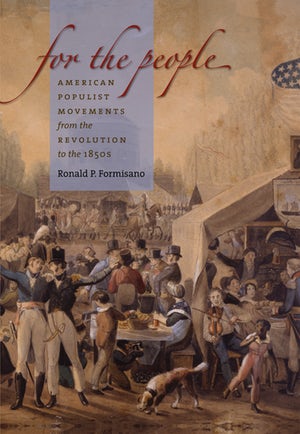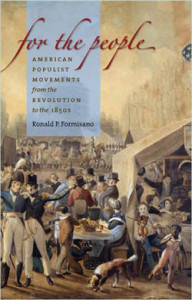Reform and Reaction: Populism in Early America

Ronald Formisano, a historian whose work ranges from the early political history of Massachusetts to the modern battle over court-ordered busing, is now seeking to revive scholarly appreciation for authentic populist social movements. In his For the People, the first of a multivolume study of populism through the nineteenth century, Formisano argues that these movements have been one of the central elements, “if not the dominant theme,” of American political culture. Populist movements, according to Formisano, have drawn on “attitudes and predispositions embedded deep in American political culture and reaching back at least to the nation’s founding.”
With his usual style and vigor, Formisano’s goal is to move beyond the “psychologizing of populist movements,” which stems from the “tendency to minimize the actual grievances of protesters, the lack of attention to the varied composition of movements…as well a failure to probe deeply enough into the social and political reality confronting movement leaders and participants.”
Drawing on extensive research and a thorough examination of modern scholarship—the footnotes alone will serve as an invaluable reference source—Formisano’s study covers major extra-governmental and third-party revolts, from the Revolutionary era to the 1850s: beginning with the Carolina Regulators of the 1760s, Shay’s Rebellion in 1786, the Democratic-Republican Societies of the early 1790s, and the Whiskey Rebellion in 1794, Formisano then moves to the rise of Anti-Masonry in the 1820s and 1830s, the violent political turmoil in New York and Rhode Island in the 1840s, and finally the anti-Catholic Know-Nothings of the 1850s. The first three chapters focus on the Revolution and its aftermath. Chapter 3, “The Taming of the Revolution,” is the best in the book. The author details the conflict in the 1790s between those who continued to use the Revolution as a “template for popular action” and those who viewed popular sovereignty merely as a rhetorical device. The touchstone of conservative ideas about sovereignty in the 1790s was legitimacy, defined, as President George Washington maintained in his Farewell Address (1796), as obedience to extant laws. For the opposition Democratic Republicans, this perspective left no space for legitimate and spontaneous citizen action against their elected representatives.
After a chapter on the transforming effects of the market revolution and the development of new social movements after the Panic of 1819, Formisano skillfully chronicles the history of the Anti-Masons and their foray into party politics. Formisano argues that the Anti-Masons were not opposed to the changes brought on by the market revolution. The movement itself developed from outrage at the 1826 cover-up of the kidnapping and murder of newspaper editor William Morgan in western New York, an area of the rapidly industrializing Genesee County. Formisano deserves particular credit for detailing the reports of three different special counsels who were appointed by the New York state legislature to “assist the prosecutions and to satisfy mounting Anti-Masonic demands for action” in the Morgan affair. The three reports highlight the widespread obstruction of justice in western New York in the months after Morgan’s kidnapping, proving that Anti-Masonic grievances could not be reduced to simple paranoia.
Chapter 8 examines New York’s anti-rent rebellion, along with Rhode Island’s brief but turbulent “Dorr War,” a failed attempt by populist constitutional reformers to seize the state government and forcibly revise the state’s antiquated constitution. Formisano’s discussion of the 1842 Dorr Rebellion relies on extensive primary research. The rebellion, led by the former Whig Thomas Dorr, was one of the most significant political and constitutional events between the age of Jackson and the election of Abraham Lincoln. By the end of the 1840s, the president, both houses of Congress, the Supreme Court, and the lower federal judiciary had all passed judgment on the tempest that erupted over Thomas Dorr’s “People’s Constitution.” Unlike many recent accounts of the Jacksonian period that have included a discussion of the Dorr Rebellion, Formisano correctly notes that the constitution that was finally adopted in the wake of the rebellion was far from liberal because it retained property qualifications for naturalized citizens.
A minor criticism of Formisano’s description of the Dorr Rebellion is that it lacks a discussion of the relationship between Rhode Island Catholics and the Dorrite rebels. Boston’s Bishop Benedict Joseph Fenwick and the two priests stationed in Providence strenuously urged Catholics not to support Dorr’s rebellion. As was the case with abolitionism, since Catholics were a minority everywhere and a suspect minority at that, supporting controversial causes such as Dorrite constitutional reform and abolitionism would have only incurred the wrath of those opposed to both and fed widespread anti-Catholic sentiment.
For the People can be profitably read as a sympathetic exposition of the various ways critics of American politics and society and adherents to popular sovereignty have been a mainstay of our political culture. While covering much of the same time period as Sean Wilentz’s Bancroft Prize-winning The Rise of American Democracy, Formisano’s work, as he himself notes, takes a much different approach. Formisano is not interested in the same “rise” of democracy, a development that Wilentz sees as the foundation of pre-Civil War antislavery politics. Those who find Wilentz’s argument persuasive will undoubtedly take issue with Formisano’s decision not to include white or black abolitionists as a major part of his story of populist movements. According to Formisano, the antislavery movement did not contain any “grassroots” leadership and therefore cannot be classified as a “populist movement.” Several historians, however, have presented convincing evidence to the contrary. Where Formisano sees the abolitionist movement as an outgrowth in many ways of the Anti-Masonic movement, other historians have detailed a vibrant grassroots abolitionism concurrent with Anti-Masonry’s development.
These caveats aside, For the People will be essential reading for students of early American politics. The book greatly expands our understanding of and appreciation for the complex and paradoxical nature of American populist movements. At the same time, it captures the many contradictions of populist movements, especially their concurrent liberal and illiberal tendencies, as well as their reactionary and progressive postures. As always, Formisano’s scholarship is a force to be reckoned with. His research will have important implications for current scholarly debates about the meaning and legacy of popular sovereignty in the decades after the Revolution.
Further Reading
Legal historian Christian Fritz’s American Sovereigns: The People and American Constitutional Tradition Before the Civil War (New York, 2007) presents a fascinating revisionist account of the doctrine of popular sovereignty. For a concise history of the 1790s see James Roger Sharp, American Politics in the Early Republic: The New Nation in Crisis (New Haven, Conn., 1993). The scholarship of Patrick T. Conley remains essential for those interested in the Dorr Rebellion. See in particular the final chapters of Democracy in Decline: Rhode Island’s Constitutional Development, 1776-1841 (Providence, R.I., 1977). For a recent account that discusses the role of Catholics in the Dorr Rebellion see Scott Molloy’s Irish Titan, Irish Toiler: Nineteenth-Century New England Labor (Lebanon, N.H., 2008). Richard Newman’s The Transformation of American Abolitionism: Fighting Slavery in the Early Republic (Chapel Hill, 2002) provides evidence for grassroots abolitionism.
This article originally appeared in issue 9.2 (January, 2009).
Erik J. Chaput is a Ph.D. candidate in early American history at Syracuse University. His dissertation is entitled, “Contested Citizenship in Nineteenth Century Rhode Island: 1842-1888.”
